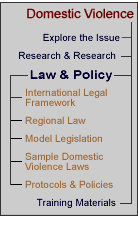|
|
|
DOMESTIC VIOLENCE: LAW AND POLICY Although regional institutions have been paying increased attention to issues of domestic violence in recent years, many of the legal developments on domestic violence have taken place through the framework of the United Nations or within individual national legal systems. The developments within the United Nations system—in particular, the drafting and signature of United Nations treaties and documents recognizing domestic violence as a human rights violation and the extraordinary work of the Special Rapporteur on Violence Against Women and the Committee on the Elimination of All Forms of Violence Against Women on the issue—have been critical to efforts to raise awareness about domestic violence, articulate state responsibility for domestic violence, and identify strategies to combat domestic violence. The United Nations, as well as some national institutions, has also developed a model domestic violence law that can provide guidance in drafting domestic violence legislation. On the national level, as well, significant advancements have been made through the drafting and passage of domestic violence laws and the creation of policies and protocols altering law enforcement, judicial, prosecutorial, or medical response to domestic violence. These laws and protocols vary considerably; some domestic violence laws, for example, criminalize domestic assault, others create civil remedies, and yet others do both. Despite their diversity, these laws can serve as useful models for new legislative and policy reform efforts. In addition, the successes and failures of these laws and protocols in other jurisdictions can be an invaluable resource in the effort to evaluate the appropriateness of adopting a particular policy or law and to anticipate any unintended negative effects the law or policy may have on victims of domestic violence. Contents: |
| Home | Contact | Feedback | Disclaimer |

